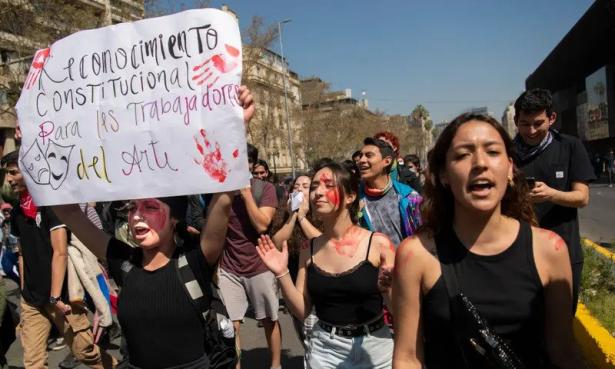Frustration at lack of progress on conditions in education and the rejection of a new draft constitution have driven a new wave of demonstrations
When the young protesters pour out of the city’s public high schools, hulking white police trucks inch towards them, their flanks dented and splattered with paint as rocks clatter off the grilles over their windshields.
Since Chile’s progressive movement was deflated by the crushing defeat of a proposed new constitution in September, high school students have taken to the streets to rekindle their demands.
The weeks since the 4 September plebiscite in which 62% of voters rejected the document have been punctuated by student marches, arson attacks and metro platform protests.
Chile’s politicians have been unable to reach any meaningful consensus on a new constitutional process, and the grinding negotiations have frustrated those who had hoped for more dramatic change.
“The demands we have now are the same as when the protests started in 2019,” said Camila Navarro, 18, a student activist from Quinta Normal, a city-centre neighbourhood.
“We want better healthcare and education, and we want to tackle inequality. Our demands haven’t changed for one simple reason: they haven’t remotely been answered.”
Chile’s recent wave of political turmoil was itself triggered by a group of high school children, who in October 2019 vaulted metro turnstiles to protest at fare rises, providing the spark for months of mass demonstrations, a new wave of progressive politicians and the decision to replace the country’s Pinochet-era constitution.
But the new charter drawn up in the year-long constitutional process that followed proved too radical for voters.
Now, after two years of pandemic restrictions and online classes, the same generation of students that first lit the fuse has emerged on to the streets to find that little has changed.
And many are frustrated by the lack of progress.
At recent protests, students spoke of rats in buildings, crumbling infrastructure and staff shortages.
Some railed against Chile’s semi-private model for education in which more than half of the country’s students attend privately run, voucher-financed schools. Others criticised what they see as sexist, Catholic ideals dominating their education; or called for vegan options on lunchtime menus.
In October, a small number of hooded protesters streamed out of a city-centre high school and torched a public bus, the latest in a series of arson attacks. Later, four soldiers and several demonstrators were injured in an apparent attack on a barracks near the school.
The return to classes has been a chastening experience for some. According to statistics compiled by Chile’s education ministry, non-attendance across the entire education system has been 98% higher in 2022 than in 2019.
“These protests are different to typical student demonstrations – they’re far more visceral and anarchic,” said Sofía Donoso, an assistant professor in sociology at the University of Chile.
“The current trend among the demonstrators is against political parties, which makes it hard to channel, but these student movements have shaped Chilean politics in recent years.”
Those currently on the street are the latest in a long lineage of student protesters in Chile: in 2001, the mochilazo protests saw secondary school students mobilise and swarm the streets, before the “penguin revolution”of 2006 – so named owing to the students’ black and white uniforms – targeted the Pinochet-era privatised education system.
Since then, student leaders have often graduated into party politics, with several members of the penguin generation taking elected office alongside Chile’s 36-year-old president, Gabriel Boric, and his contemporaries who hail from 2011 university strikes.
But the latest protests have struggled to win broader support, with the students trapped between unfulfilled promises and the public’s collective exhaustion after three turbulent years of unrest, pandemic restrictions, and voting (two constitutional plebiscites, primaries, two rounds of a general election, and a vote to chose delegates for the constituent assembly).
Boric, himself a protest leader in his university days, has reiterated his support for a new constitutional process, but has little political capital to fall back on after the defeat of the proposed constitution.
And his background in social movements has increased scrutiny on the government’s handling of the latest wave of student protests.
“We are a government that is open to dialogue, but we have repeatedly condemned the violence,” said Marco Antonio Ávila, Chile’s education minister.
Ávila has met with student delegates from several schools across the capital, including the Instituto Nacional, a prestigious high school in the centre of Santiago that has educated 18 of Chile’s presidents.
The school is a notorious hotbed for protest, and several windows facing the street are smashed. The concrete lip above an office window is blackened from a fire started by students.
According to one caretaker who has worked at the school for more than 20 years, students gather in a courtyard to prepare molotov cocktails before spilling out to confront police.
The Instituto Nacional did not respond to a request for comment.
Ávila has made a 60bn-peso (£56m) emergency fund available for urgent repairs to infrastructure at schools across the country.
But student leaders insist that an overarching solution must be found.
“First, we need a new constitution,” said Navarro. “Schools are run like businesses, and we need to put students first, not profit.”
“We’ve already waited too long. All we’ve received so far is repression.”
===


Spread the word